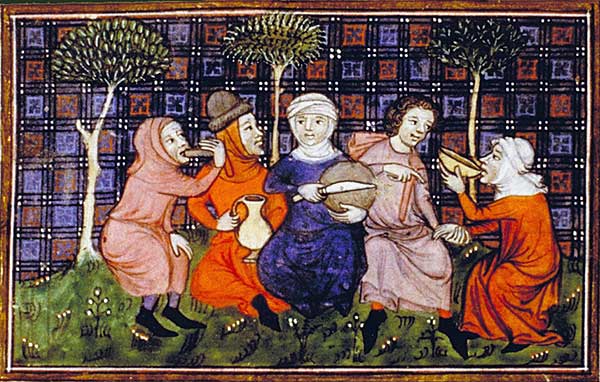Food and Drink in Medieval England
As in the modern day, the food and drink of Medieval England varied dramatically. While the nobility enjoyed luxurious feasts, peasants consumed only very basic meals.
Most of the population, including peasants, based their meals on grains, seasonal vegetables and, occasionally, meat. This diet may not have been particularly varied, but it did provide peasants with enough energy and nutrition to work long hours.
Bread was also included in most meals during medieval times, but it looked very different to the bread we know today. With access to only barley or rye, peasants would produce very dense, dark loaves based on rye and wheat flour. Should they be lacking in grain following a bad harvest, other ingredients would be substituted into the mixture including acorns, beans and peas.
Regardless of the quality of the bread, peasants were not allowed to cook bread at home and were instead required to cook it in the lords oven. However, they would be charged for this

Another staple of the medieval diet was pottage, which was a between soup and stew in terms of consistency and contained oats. There were many different types of pottage made, often including seasonal vegetables such as parsnips, turnips and leeks.
Although meat was not as readily available as it is now, pigs provided a relatively steady supply to peasants as they could be killed at any time of year and were able to forage for food themselves; their ability to live off acorns from local woods made them a cheap meat to produce.
Mutton, from sheep, was also consumed by peasants but they were often so thin that the meat produced was not of a high quality. However, their blood was also used to create black pudding.
There were wild animals available at this time including rabbits, boars and diet. However, these animals belonged to the lord who owned the land, which meant peasants risked serious punishment such as having their hands cut off. There were cases where lords would allow peasants permission to hunt on their land, but this permission would usually only cover squirrels and hedgehogs.
Permission granted by the lords may also cover certain types of fish in their nearby river, potentially including gudgeon, grayling and dace. However, only lords were allowed to hunt salmon or trout, which would have been kept in a large pond somewhere on their estate.
Drink available to peasants included water and milk. However, the water was often sourced from rivers and usually full of bacteria, while milk didn’t last very long due to the lack of refrigeration. Many villagers would drink ale to protect them from the germs in the water, but this took a long time to brew so barley was often used. This would be soaked for a few days and then germinated to produce malt. Once this had been dried and ground down, it would be fermented in hot water. In some cases the lords would allow peasants to sell this ale, but usually it was for personal consumption only.
The following table further demonstrates the differences between the diets of the rich and poor in medieval times:
| Meal | Lord | Peasant |
|---|---|---|
| Breakfast | Breakfast occurred between 6 and 7am and people took their time over it. A lord may typically have had white bread, three meat dishes three fish dishes (more fish on a saint's day) and would have drunk wine or ale. | A peasant would eat their breakfast at sunrise and it would normally consist of dark bread (usually made from rye) with a drink of ale. |
| Dinner | Dinner was between 11am and 2pm. Lords would normally have three courses but each one may have had another four to six courses in it. Meat and fish would be available with wine and ale. Only the small amounts of the dishes would probably be eaten and the remainder thrown away. However, the lord's kitchen workers and servants could have the opportunity to take food for themselves if the lord didn’t know about it. | Dinner for the poor was known as a "ploughman's lunch" because peasants would eat it out in the fields where they worked. This meal would typically be dark bread and cheese and possibly some meat along with a flask of ale. Peasants would have their dinner between about 11am to midday |
| Supper | Supper for the rich was eaten between 6 and 7pm. It would look a lot like the dinner but it would include dishes that were a little more unusual, such as pigeon pie, woodcock and sturgeon. There would also be wine and ale to drink. | Peasants would have their supper near sunset, so the time of day would change depending on the seasons. Vegetable pottage would be a family’s staple meal and maybe some meat or fish too. They would also have bread and drink ale. |
See also: Medieval Towns
MLA Citation/Reference
"Food and Drink in Medieval England". HistoryLearning.com. 2025. Web.
